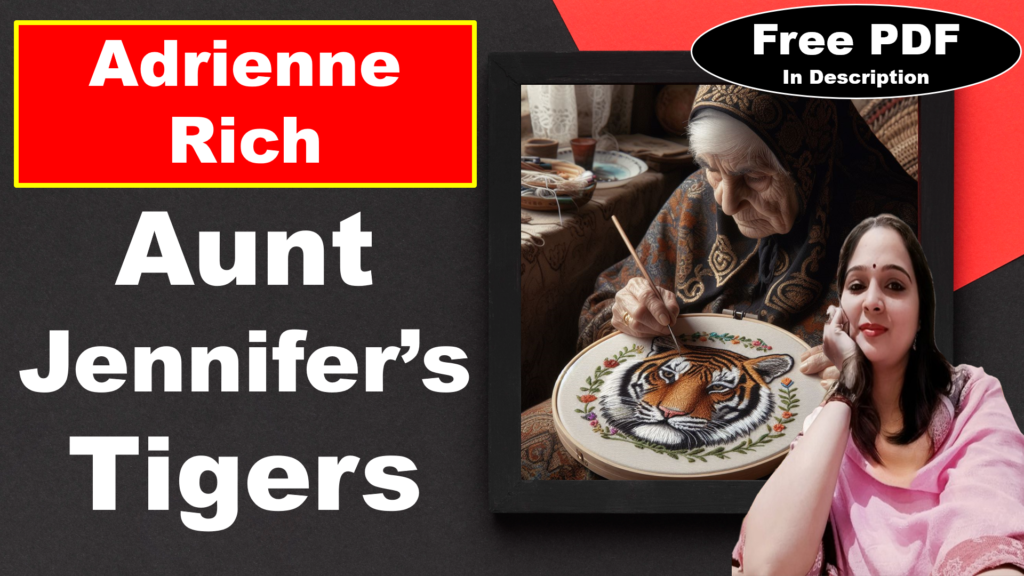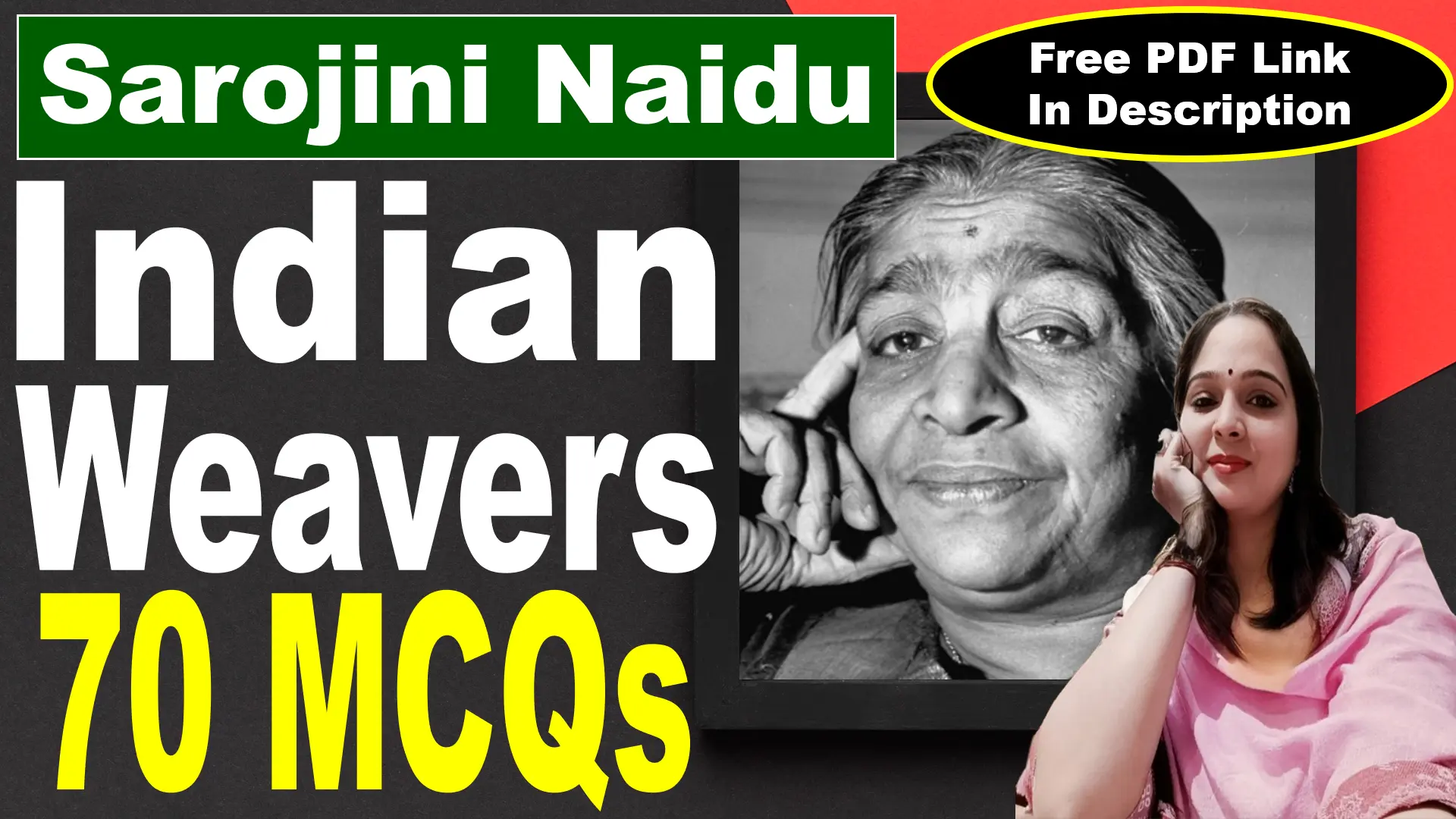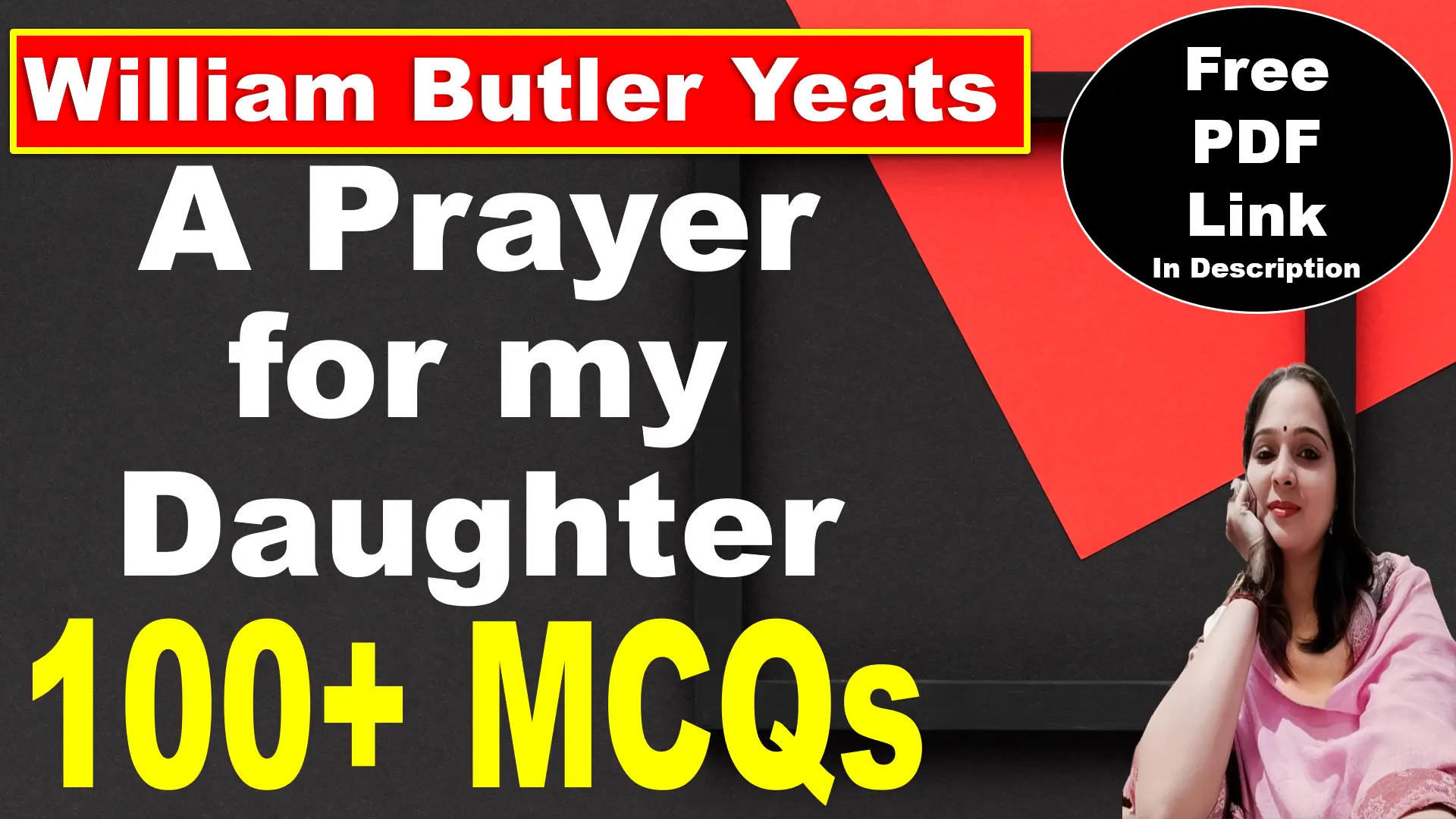
Aunt Jennifer’s Tigers by Adrienne Rich | Aunt Jennifer’s Tigers | Adrienne Rich | | Explanation | Summary | Key Points | Word Meaning | Questions Answers | Free PDF Download – Easy Literary Lessons
Aunt Jennifer’s Tigers
Aunt Jennifer’s tigers prance across a screen,
Bright topaz denizens of a world of green.
They do not fear the men beneath the tree;
They pace in sleek chivalric certainty.
Aunt Jennifer’s fingers fluttering through her wool
Find even the ivory needle hard to pull.
The massive weight of Uncle’s wedding band
Sits heavily upon Aunt Jennifer’s hand.
When Aunt is dead, her terrified hands will lie
Still ringed with ordeals she was mastered by.
The tigers in the panel that she made
Will go on prancing, proud and unafraid.
Aunt Jennifer’s Tigers by Adrienne Rich: YouTube Link
Aunt Jennifer’s Tigers Poem Analysis
Line 1: Aunt Jennifer’s tigers prance across a screen,
Explanation
The poem begins with a vivid image of the tigers, created by Aunt Jennifer. They are not physically present, but rather depicted on a “screen,” possibly a tapestry or embroidery. The word “prance” suggests their freedom and vitality.
Poetic Devices
Imagery: The visual image of the prancing tigers is strong and immediate.
Personification: The tigers are given human-like qualities by “prancing.”
Line 2: Bright topaz denizens of a world of green.
Explanation
This line continues describing the tigers, comparing their color to “topaz,” a precious gemstone. They are described as “denizens,” meaning inhabitants, of a “world of green,” suggesting a vibrant and natural environment.
Poetic Devices
Metaphor: The tigers are compared to topaz, emphasizing their brightness and value.
Imagery: The green world further reinforces the contrast between the tigers’ freedom and Aunt Jennifer’s confinement.
Line 3: They do not fear the men beneath the tree;
Explanation
This line introduces the men, who are positioned “beneath the tree,” possibly representing a patriarchal society. The tigers are free from their fear, suggesting they exist outside the constraints of that society.
Poetic Devices
Juxtaposition: The contrast between the fearless tigers and the men emphasizes the powerlessness women often face.
Symbolism: The men beneath the tree could symbolize a controlling male presence in Aunt Jennifer’s life.
Line 4: They pace in sleek chivalric certainty.
Explanation
The tigers continue to be described with terms like “sleek” and “chivalric,” showcasing their grace and confidence. The word “certainty” suggests they have an unshakeable belief in their own power.
Poetic Devices
Imagery: The adjectives “sleek” and “chivalric” add further detail to the tigers’ image.
Personification: The tigers are again given human-like qualities, this time resembling noble knights.
Line 5: Aunt Jennifer’s fingers fluttering through her wool
Explanation
The poem shifts its focus to Aunt Jennifer herself. Her hands are described as “fluttering” through wool, suggesting a nervous or agitated state.
Poetic Devices
Imagery: The image of fluttering hands creates a sense of restlessness and unease.
Symbolism: The wool could symbolize the domesticity and limitations imposed upon women.
Alliteration: Alliteration in “fingers” and “fluttering” adds a light and delicate touch.
Line 6: Find even the ivory needle hard to pull.
Explanation
This line further emphasizes Aunt Jennifer’s difficulty and frustration. Even the simple task of pulling a needle becomes challenging, highlighting her physical limitations.
Poetic Devices
Metaphor: The needle could be seen as a metaphor for the challenges and obstacles Aunt Jennifer faces in her life.
Line 7: The massive weight of Uncle’s wedding band
Explanation
This line introduces the wedding band, a powerful symbol of Aunt Jennifer’s marriage. It is described as “massive,” suggesting its burden and restrictive nature.
Poetic Devices
Symbolism: The wedding band represents the institution of marriage and the limitations it can place on women.
Imagery: The weight of the band is a concrete image that symbolizes Aunt Jennifer’s oppression.
Line 8: Sits heavily upon Aunt Jennifer’s hand.
Explanation
This line continues to emphasize the weight and burden of the wedding band. Its placement on her hand symbolizes its direct impact on her life and freedom.
Poetic Devices
Symbolism: The hand is a symbol of action and agency, highlighting how the marriage restricts Aunt Jennifer’s ability to act freely.
Line 9: When Aunt is dead, her terrified hands will lie
Explanation
This line introduces a dark and somber tone, foreshadowing Aunt Jennifer’s death. The word “terrified” suggests the fear and anxiety she has endured throughout her life.
Poetic Devices
Foreshadowing: The mention of death hints at Aunt Jennifer’s eventual escape from her suffering.
Imagery: The image of still hands creates a sense of finality and loss.
Line 10: Still ringed with ordeals she was mastered by.
Explanation
This line continues to describe Aunt Jennifer’s death. Her hands will still be “ringed” with the “ordeals” she endured in life, suggesting her inability to fully escape their impact. The use of the passive voice (“mastered by”) emphasizes the powerlessness she felt throughout her life.
Poetic Devices
Metaphor: The ordeals are metaphorically represented as rings, suggesting they were inescapable and left their mark.
Symbolism: The rings could also symbolize the enduring legacy of the societal constraints Aunt Jennifer faced.
Line 11: The tigers in the panel that she made
Explanation
This line shifts the focus back to the tigers, now described as part of a “panel,” possibly a completed tapestry or embroidery. The use of the word “made” emphasizes Aunt Jennifer’s creativity and artistic ability.
Line 12: Will go on prancing, proud and unafraid.
Explanation
This line concludes the poem with a hopeful image of the tigers. They will continue to “prance” with pride and without fear, even after Aunt Jennifer’s death.
Poetic Devices
Contrast: The tigers’ freedom and joy stand in stark contrast to Aunt Jennifer’s suffering, offering a sense of hope and liberation.
Symbolism: The tigers symbolize the enduring power of imagination and art, which can transcend even the limitations and constraints of reality.
Alliteration: The repetition of “prancing, proud, and unafraid” creates a powerful and rhythmic conclusion.
Overall Analysis:
“Aunt Jennifer’s Tigers” uses powerful imagery and symbolism to explore the themes of female oppression and the yearning for freedom. The contrast between the vibrant and free tigers and Aunt Jennifer’s trapped and fearful life creates a poignant and thought-provoking poem. While the poem acknowledges the hardships faced by women, it also offers hope through the image of the tigers, suggesting that the spirit of defiance and the power of art can endure even in the face of adversity.





